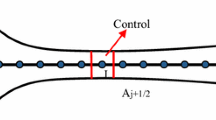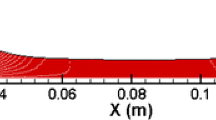Abstract
In the last stages of steam turbines, the formation of liquid droplets causes losses and reduces turbine efficiency. One of the major problems of wet steam flow is the presence of the liquid phase, which volumetric heating reduces the wetness. One of the disadvantages of adding volumetric heating is increasing entropy generation and cost. Considering that three important parameters, including entropy losses, economic cost, and wetness play, an important role in the turbine blade flow. Reducing wetness can be accompanied by increasing heat and, on the other hand, adding heat leads to increasing cost and entropy. Therefore, as a first, a novel entropy, economic, and wetness (EEW) method is introduced to achieve optimal volumetric heating. Numerical simulation of the turbulent steam flow, SST k–ω model is used. Results are validated with experimental and numerical previous studies for two different geometries. It was also found that when the volumetric heating is optimal, these three parameters in EEW method have the lowest value. Moreover, EEW method is recommended for future research, and it is more optimized compared to the other types of methods. Therefore, corrosion and shock condensation can be decreased by using EEW method.








Similar content being viewed by others
Abbreviations
- C l :
-
Specific heat of liquid (J kg−1 K−1)
- C V :
-
Vapor isochoric specific heat (J kg−1 K−1)
- E :
-
Total energy (J)
- K b :
-
Boltzmann’s constant
- K t :
-
Thermal conductivity (W m−1 K−1)
- m r :
-
Liquid mass (kg)
- M m :
-
Molecular mass (kg mol−1)
- P :
-
Pressure (Pa)
- q c :
-
Condensation coefficient
- r :
-
Droplet radius (m)
- s :
-
Specific entropy (J kg−1 K−1)
- S :
-
Entropy
- t :
-
Time (s)
- u :
-
Velocity components (m s−1)
- V :
-
Volume (m3)
- Q :
-
Volumetric heating (W m−3)
- W :
-
Wetness fraction
- x, y, z :
-
Cartesian direction (m)
- Γ :
-
Mass generation rate (kg m−3 s−1)
- η :
-
Number of liquid droplets (1 m−3)
- θ :
-
Non-isothermal correction coefficient
- ξ :
-
Loss coefficient
- ρ :
-
Density (kg m−3)
- ϱ :
-
Mean rate-of-strain tensor
- σ :
-
Liquid surface tension (N m−1)
- τ :
-
Viscous stress tensor (Pa)
- l:
-
Liquid
- v:
-
Vapor
- d:
-
Droplet
- lv:
-
Liquid–vapor
- n, m:
-
Number of control points
- s:
-
Saturation
- f:
-
Fuel
- g:
-
Gas
- t:
-
Turbulent
- *:
-
Critical condition
References
Bakhtar F, Young JB, White AJ, Simpson DA. Classical nucleation theory and its application to condensing steam flow calculations. Proc Inst Mech Eng Part C J Mech Eng Sci. 2005;219:1315–33.
Courtney WG. Remarks on homogeneous nucleation. J Chem Phys. 1961;35:2249–50.
Kantrowitz A. Nucleation in very rapid vapor expansions. J Chem Phys. 1951;19:1097–100.
Mahpeykar MR, Teymourtash AR, Amiri Rad E. Reducing entropy generation by volumetric heat transfer in a supersonic two-phase steam flow in a Laval nozzle. Int J Exergy. 2011;9:21–39.
Lakzian E, Masjedi A. Slip effects on the exergy loss due to irreversible heat transfer in a condensing flow. Int J Exergy. 2014;14:22–37.
Dykas S, Majkut M, Smołka K, Strozik M. Analysis of the steam condensing flow in a linear blade cascade. J Power Energy. 2018;232:501–14.
Vatanmakan M, Lakzian E, Mahpeykar MR. Investigating the entropy generation in condensing steam flow in turbine blades with volumetric heating. Energy. 2018;14:147–701.
Moore MJ, Ederhof A. Instrumentation for wet steam. In: Moore MJ, Sieverding CH, editors. Twophase steam flow in turbines and separators. Washington: Hemisphere; 1976. p. 191–260.
Petr V. Measurement of an average size and number of droplets during spontaneous condensation of supersaturated steam. Proc Inst Mech Eng. 1969–1970; 184:73–79.
Gyarmathy G, Lesch F. Fog droplet observations in Laval nozzles and in an experimental turbine. Proc Inst Mech Eng. 1969;184(7):29–36.
Walters PT. Optical measurement of water droplets in wet steam. In: Proceedings of institution of mechanical engineers, conference on heat and fluid flow in steam and gas turbine plant, Warwick, UK, April 1973, pp 66–74.
Gyarmathy G. Grundlagen einer theorie der nassdampfturbine. PhD Thesis, ETH Zu00 rich, Juris, Zu0 0 rich, 1962.
Laali AR. A new approach for assessment of the wetness losses in steam turbines. In: Institution of mechanical engineers conference: Turbomachinery—Latestdevelopments in a changing scene, London, UK, March 1991, pp. 155–166.
Bakhtar F, Heaton AV. Effects of wake chopping on droplet sizes in steam turbines. Proc IMechE Part C J Mech Engineering Sci. 2005;219:1357–67.
Petr V, Kolovratnik M. Modelling of the droplet size distribution in LP steam turbine. Proc IMechE Part A J Power Energy. 2000;214:145–52.
Guha A, Young JB. The effect of flow unsteadiness on homogeneous nucleation of water droplets in steam turbines. Philos Trans R Soc Ser A. 1994;349:445–72.
Niazmand A, Farzaneh-Gord M, Deymi-Dashtebayaz M. Exergy analysis and entropy generation of a reciprocating compressor applied in CNG stations carried out on the basis Models of Ideal and Real Gas. Appl Therm Eng. 2017;124:1279–91.
Farzaneh-Gord M, Arabkoohsar A, Dasht-bayaz MD, Machado L, Koury RNN. Energy and exergy analysis of natural gas pressure reduction points equipped with solar heat and controllable heaters. Renew Energy. 2014;72:258–70.
Deymi-Dashtebayaz M, Kazemiani-Najafabad P. Energy, exergy, economic, and environmental analysis for various inlet air cooling methods on Shahid Hashemi-Nezhad gas turbines refinery. Energy Environ. 2018;30:481–98.
Deymi-Dashtebayaz M, Arabkoohsar A, Darabian F. Energy and exergy analysis of fluidized bed citric acid dryers. Int J Exergy. 2017;22:205–17.
Bhatti MM, Abbas T, Rashidi MM. Numerical study of entropy generation with nonlinear thermal radiation on magnetohydrodynamics non-Newtonian nanofluid through a porous shrinking sheet. J Magn. 2016;21(3):468–75.
Rashidi MM, Mohamadi F, Abbasbandy S, Alhuthali MS. Entropy generation analysis for stagnation point flow in a porous medium over a permeable stretching surface. J Appl Fluid Mech. 2015;8(4):753–65.
Keisari SJ, Shams M. Shape optimization of nucleating wet-steam flow nozzle. Appl Therm Eng. 2016;103:812–20.
Abadi SMANR, Ahmadpour A, Abadi SMNR, et al. CFD-based shape optimization of steam turbine blade cascade in transonic two phase flows. Appl Therm Eng. 2017;112:1575–89.
Somesaraee MT, Rad EA, Mahpeykar MR. Analytical investigation of simultaneous effects of convergent section heating of Laval nozzle, steam inlet condition, and nozzle geometry on condensation shock. J Therm Anal Calorim. 2018;133(2):1023–39.
Salmani F, Mahpeykar MR. Dimensional analysis for estimating wetness terms of condensing steam using dry flow data. J Therm Anal Calorim. 2019;137(6):2121–2134.
Yousif AH, Al-Dabagh AM, Al-Zuhairy RC. Non-equilibrium spontaneous condensation in transonic steam flow. Int J Therm Sci. 2013;68:32–41.
Patel Y, Patel G, Turunen-Saaresti T. Influence of turbulence modelling on non-equilibrium condensing flows in nozzle and turbine cascade. Int J Heat Mass Transf. 2015;88:165–80.
Mahpeykar MR, Lakzian E, Amirirad E. Reduction of thermodynamic losses in a supersonic nucleating steam nozzle by spraying water droplets. Sci Iran. 2009;16:253–62.
Grazzini G, Milazzo A, Piazzini S. Prediction of condensation in steam ejector for a refrigeration system. Int J Refrig. 2011;34:1641–8.
Wang X-D, Dong J-L, Wang T, Tu J-Y. Numerical analysis of spontaneously condensing phenomena in nozzle of steam-jet vacuum pump. Vacuum. 2012;86:861–6.
Hill PG. Condensation of water vapour during supersonic expansion in nozzles. J Fluid Mech. 1966;25:593–620.
Nikkhahi B, Shams M, Ziabasharhagh M. A numerical investigation of two-phase steam flow around a 2-D turbine’s rotor tip. Int Commun Heat Mass Transf. 2009;36:632–9.
Young JB. An equation of state for steam for turbomachinery and other flow calculations. Trans ASME J Eng Gas Turbines. 1988;110:1–7.
Wilcox DC. Turbulence modeling for CFD. La Canada: DCW Industries; 1998.
Borgnakke C, Sonntag RE. Fundamentals of thermodynamics: Part 1. 7th ed. John Wiley & Sons, Inc; 2009.
Roe PL. Characteristic-based schemes for the Euler equations. Annu Rev Fluid Mech. 1986;18:337–65.
Bakhtar F, Webb RA, Shojaee-Fard MH, Siraj MA. An investigation of nucleating flows of steam in a cascade of turbine blading. J Fluids Eng. 1993;115:128–34.
Bakhtar F, Mahpeykar MR, Abbas KK. An investigation of nucleating flows of steam in a cascade of turbine blading-theoretical treatment. J Fluids Eng. 1995;117:138–44.
Bakhtar F, Zamri MY, Rodriguez-Lelis JM. A comparative study of treatment of two-dimensional two-phase flows of steam by a Runge-Kutta and by Denton’s methods. Proc Inst Mech Eng Part C J Mech Eng Sci. 2007;221:689–706.
Author information
Authors and Affiliations
Corresponding author
Additional information
Publisher's Note
Springer Nature remains neutral with regard to jurisdictional claims in published maps and institutional affiliations.
Rights and permissions
About this article
Cite this article
Hosseini, R., Lakzian, E. Optimization volumetric heating in condensing steam flow by a novel method. J Therm Anal Calorim 140, 2421–2433 (2020). https://doi.org/10.1007/s10973-019-09001-1
Received:
Accepted:
Published:
Issue Date:
DOI: https://doi.org/10.1007/s10973-019-09001-1




